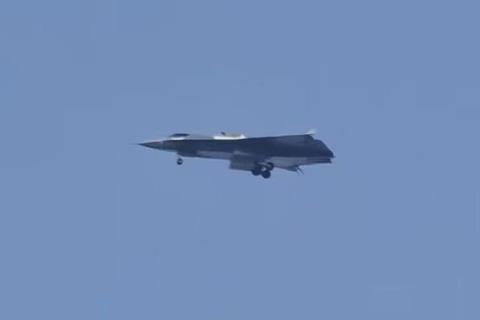Beijing has staged a late-year aerospace coup by showing off not one, but two developmental stealth aircraft.
Images of the first aircraft, a large delta-winged platform that appears to have three engines, started appearing on social media on 26 December, the birthday of the late Mao Zedong, China’s ruler from 1949 to 1976.
The first jet was accompanied by a two-seat Chengdu J-20S fighter acting as a chase plane, suggesting the jet was filmed above the western city of Chengdu, and hinting that the jet was developed by the Chengdu Aerospace Corporation.
The second aircraft is smaller and appears to be powered by a single engine. It was accompanied by what appears to be a Shenyang J-16. This could indicate that it was developed in China’s northeastern city of Shenyang, home to Shenyang Aircraft Corporation.
The images quickly spread across China’s tightly restricted social media platforms. Neither state media nor the defence ministry have made announcements about the jets – let alone provided any programme details. Still, the images and video – all shot in clear blue skies - would have quickly vanished if not for the blessings of Beijing.
中国六代机首飞 https://t.co/EyCxdK77pB pic.twitter.com/6iWcQ8J9v1
— Sweet Clay (@Clay_PLAPAP) December 26, 2024
As with all military images and news that appear on Chinese social media, these latest items need to be treated with caution. Most China observers feel the images are legitimate, but Beijing is a master of disinformation.
Nonetheless, the unprecedented appearance of the two aircraft underlines China’s relentless efforts to improve its airpower capabilities. The development of new manned and unmanned aircraft is part of a broader effort to advance China’s military, which is undergoing the greatest peacetime build-up of a military since Nazi Germany’s rearmament before the Second World War.
The first, larger design features a double delta-wing and is China’s first tailless combat aircraft. The jet has an angled trailing edge that intersects with its thrust nozzles.
A unique feature is the layout of its intakes, with two under the wings and one above the fuselage. An image that appears to show the jet on the ground shows three thrust outlets.
Underlining the aircraft’s size is its double-bogie main landing gear and comparisons with the accompanying J-20S. A large space between the main landing gear wells suggests a large central weapons bay.
The three engines are located well to the rear. They appear to be some distance from the intakes: a key feature of stealth aircraft are long, snake-like inlets lined with radar absorbing material that prevents the deflection of radar waves.
Whether the aircraft is merely a demonstrator, an early example of a sixth-generation fighter, or a strike aircraft is not known. One possibility is that the aircraft is a prototype of the mysterious JH-XX tactical bomber, one of two bombers known to be under development in China – the other is the Xian H-20 stealth bomber.
A tri-engine configuration would be exceedingly unusual for a combat aircraft. While improving power and thrust, it would add complexity, weight, and fuel consumption. Moreover, the aircraft could suffer an endurance penalty – although this could be offset by China’s growing air-to-air refuelling capabilities.
Two engines, such as with the developmental Northrop Grumman B-21, is a more conventional solution. The American aircraft uses a derivative of the Pratt & Whitney F135 found in the Lockheed Martin F-35 fighter. China’s closest analogue to the F135 is understood to be the Shenyang WS-15, which is designed for the J-20.
Still, the third engine could suggest that high speed is a priority for the new aircraft, whereas the B-21 is purely subsonic.
As for sensors, the Chengdu jet’s large nose offers plenty of space for an active electronically scanned array radar. The aircraft does not appear to have an electro-optical targeting system, a key feature on modern stealth aircraft.
The appearance of one mystery stealth aircraft in the skies of secrecy-obsessed China is major news. The appearance of a second new type on the same day is unprecedented.
The second jet is considerably smaller and the images less clear. The aircraft lacks a vertical stabiliser but appears able to change the configuration of its horizontal stabilizers.
Crucially, the images that have appeared online make it difficult to ascertain if the aircraft has a cockpit, or whether the jet is unmanned. If it is unmanned, developers clearly feel confident flying the jet over a heavily populated region.
The wide fuselage suggests internal space for the carriage of weapons, and the aircraft features a standard landing gear configuration for a fighter, with single-wheel main landing gear.
China's Shenyang sixth-generation aircraft test flight, this is another Chinese sixth-generation aircraft pic.twitter.com/37MPIn96jB
— 笑脸男人 (@lfx160219) December 26, 2024
While both aircraft will remain shrouded in mystery for some years to come, it is clear that Beijing is sending a message that it is looking beyond its already impressive stable of stealth jets in the form of the J-20 and J-35.
Are the new aircraft indicative of so-called “six-generation” designs? If so, they will need to demonstrate electronic warfare, sensing, speed, and stealth characteristics well in advance of China’s current designs. Moreover, they will need to serve as powerful C3 – command, control, and communications - nodes in the rapid, highly redundant kill webs that will characterise the wars of the future.
By unveiling two modern combat designs on 26 December, China’s rulers have paid high tribute to one of the 20th century’s most infamous despots. China aviation watchers also received a slightly belated - albeit very welcome - Christmas present.
Most important, Beijing has given Western defence planners, who are in a muddle about what exactly the future of airpower looks like, yet more to worry about in 2025.








































